|
Although I had moved away from Lake Creek and the home I grew up in, the memory
of those left behind were forever on my mind, especially, Uncle Tom.
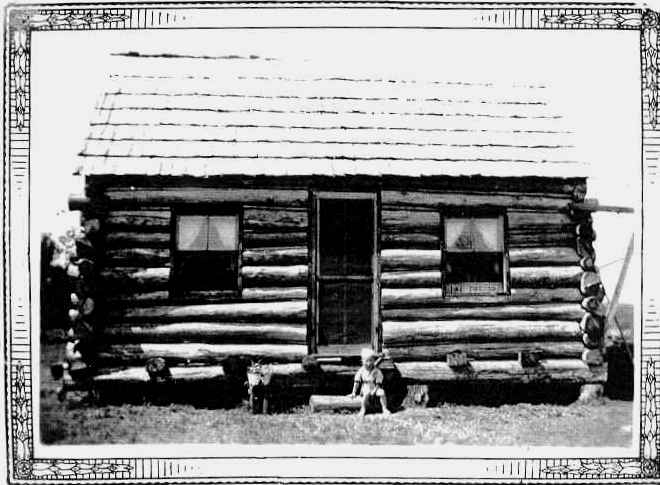
Earl Johnson sitting on the step of their log house. Picture taken
about 1936. |
 |
The years that followed brought many difficult hardships to Uncle Tom and his new family, and
looking back and remembering the old days and the stressful tasks they endured, I wonder how they coped with them. The house
didn't have any water and Uncle Tom had to haul water from a spring about two miles away on their
neighbor's land. They were good neighbors and let them have all the water they wanted, for the spring
never went dry. Uncle Tom would load wooden barrels in the wagon, pulled by mules or horses. Earl can remember
going with him for the water; he must have been about three or four years old. Uncle Tom drew the water from
the spring with a bucket tied to a long rope and filled the barrels.
After a time he dug a cistern close to their house. He put rain gutters on the house to
catch the rain water and send it into the cistern. When it didn't rain for awhile the cistern would go dry and again he had
to haul water. Earl remembers his mama (Nell) drawing water from the cistern with a rope and bucket for drinking, cooking,
washing dishes, clothes and for bathing. They took a bath in the washtub, the same tub she used to wash clothes. She did
the laundry by putting a rub board in the tub and used a big bar of soap, usually homemade lye soap. For the really dirty
clothes, like Uncle Tom's work clothes, she used a large, black pot called a wash pot. She filled the pot with water
and built a fire under and around it. When the water boiled she took a long stick, she called a punching stick, and punched
the clothes around. This boiling action was similar to the agitation of a washing machine. |
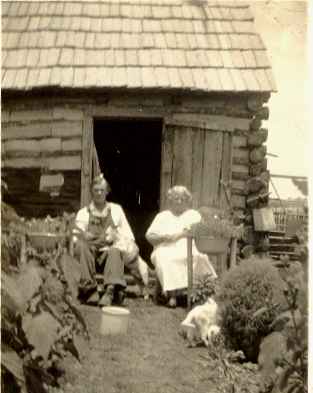
|
Kenny Shelton & Nellie Stone (Big Mama & Pa) in front of their log house. |
 |
Nell made a garden every year and grew most of their food. Big Mama and Pa helped
and they grew enough for all of them. Uncle Tom and Pa also had an orchard and raised peaches, plumbs,
figs and other fruit. They would raised extra food for canning. Nell and Big Mama would put the food in fruit jars and
put them in a pressure cooker. Then they had food during the winter. This was their only way of preserving food
for they had no refrigerator or freezer. They wouldn't have done them much good anyway, for they had no electricity.
Just about all of their food came from the farm; Uncle Tom always raised about
a half acre of sorghum cane for making sorghum molasses. He and Pa would cut the stalks of cane and load them on the wagon
and take them to a syrup mill. They didn't have enough money to pay the man for making the syrup so they paid him with a percentage
of what was made. This method of payment was used for other things also, such as for grinding corn into meal. Uncle Tom would
take a wagon load of corn to a grinding mill in Cooper to be ground into corn meal and pay the man with a percentage of the
meal. He also had beehives that produced enough honey for them and Pa and Big Mama.
He always had hogs for meat and sometimes a calf. Uncle Tom and Pa would kill and
butcher them. Everyone always looked forward to this day for the fresh meat. It always had to be on a cold day so
the meat would not spoil. They boiled the hog fat in a washpot to make lard. Nell used it for all her cooking. After
they cut up the meat they persevered it by rubbing it with a salt-like substance called sugar cure. The sugar cured meat would
last throughout the winter but had to be eaten before hot weather. They also raised sweet potatoes that would last through
the winter. Uncle Tom had a way to persevere them by digging a hole in the ground and putting hay in it. He laid
the sweet potatoes on the hay and covered them with more hay, then cover it with sheet iron. He also had chickens and lots
of eggs; sometimes they had extra eggs to sell.
They had a few cows and always had plenty of milk and butter and Uncle Tom sold
some of the milk. Pat Ayles, Uncle Tom's uncle, had a milk route. Pat and Winnie (Granny's sister) lived about a
mile south of them; they could look across the field and see their house. Pat would come by in an old flat bed truck
and pick up the cans of milk, five and ten gallon cans. Sometimes his daughter Virginia, would come with him to help and sometimes
she ran the route by herself. The money from the sale of the milk sure helped them out.
Later many farmers bought a cream separator; it would separate the cream from the milk. Once
a week, usually on Saturday, they would go to Cooper and take the cans of cream to a creamery and sell it.
Later they sometimes shipped the cans of milk by train from Paris to the Sooner Creamery in Oklahoma City.
When Earl was five years old his mama told him that they were going to get him
a little sister. He asked where they were getting her from. Since he was too young to know about the birds and the
bees she told him they had ordered her from the Sears Roebuck mail order catalog. She knew he understood about the
catalog for they ordered a lot of things from it. Earl opened the catalog to the little girls clothing section
and saw a pretty little girl and said to his mama, "I hope it's this one." She looked and saw the girl was modeling Kerrybrook
dresses, so she decided to name her either Kerry or Brook. When she was born she named her Kerry.
These pictures are some of Uncle Tom's photography from 1925. |
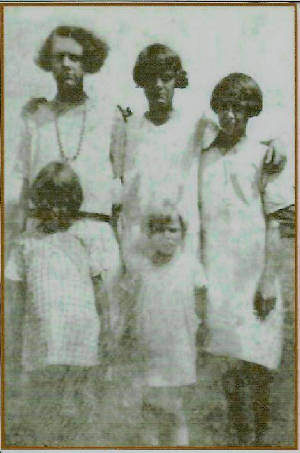
Granny's Girls:
Aunt Harvena, Aunt Sue Ann, Aunt Nancy
Vivian and Mary
In my Autobiography, Thoughts of Yesterday, I told how fond I was of Uncle Wes Tom. I told how he
could do anything, or make anything, if he had the materials. Often he had to make his own 'make-do' materials.
He was into photography at one time. He did it all. He bought some kind of paper, took the picture, then developed
it. In the first two pictures, which were made in 1925, you see Granny's girls: Harvena (Aunt Red) is the
tallest one, then Aunt Sue Ann, Aunt Nancy, Vivian (me) and the smallest one is Mary Louise. My little
sister, Mary, doesn't look very happy and I am hiding my face. Anyway, you can see that Uncle Tom was a great
amatuer photographer. I don't remember where the picture was taken, but I think that is Granny's barn in the background.
This picture was almost black.
The third picture shows Uncle Tom getting on his motor cycle. We called it a motor cycle but I guess it was more
like a motor bike. Anyway we had some fun rides on it. Granny was sure we were going to be killed.
Uncle Tom just laughed at her. He was really always cautious and careful when he had one of us on the bike with
him.
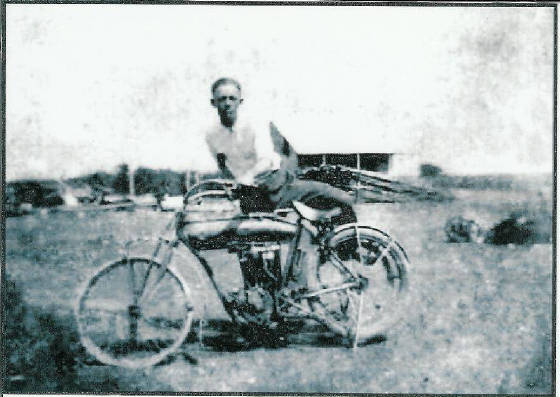
This is a picture of Uncle Tom, Aunt Nancy, Granny, Vivian (me) holding Uncle Tom's hand and Mary. Cousin
Earl has enhanced, lightened, and sharpened the images. This picture was so old I, it was almost
totally black. Earl did a great job with it. You can see the old 'Flying Ginny' that Uncle Tom made. The
Flying Ginny was made from trees that he brought up from the bottom land forest. He set the middle pole in some
kind of ball bearings and anchored it in four directions. He had to have help from some of the relatives and friends
to hold it up and work on it. Each end had a little seat. It worked like a Merry-Go-Round. It really
worked very well. We had a lot of fun with that. It was on the east side of Granny's house and the chimney was on the
west side of the house. If you look closely, you can see the chimney on top of Granny's head in
the background. The gin was on the west side of Granny's house. After he made the Flying
Ginny, he made the Ferris Wheel. We have a picture of Aunt Sue sitting in one of the seats. I don't know when
he took the Flying Ginny and Wheel down, but I think it was when we moved to Craddock. He was afraid to leave
them in the yard because someone might be hurt when he wasn't around to keep them safe.
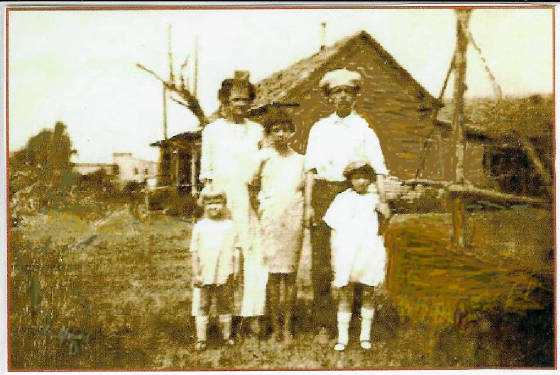
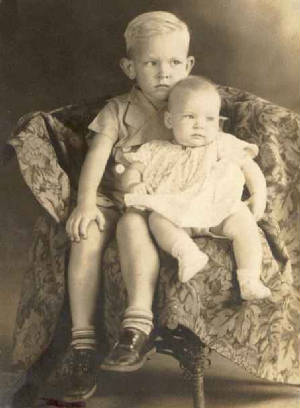
THIS IS EARL AND KERRY
Having another child greatly increased Uncle Tom and Nell's hardships even more,
for the depression was still not over. Money was still hard to come by so Uncle Tom continued to work at the gin
in the fall after his crops were in. He bought an old Model T. Ford but most of the time it wouldn't run so he walked to and
from the gin. The gin was about a mile from their house but they could hear the steam whistle when they blew it. Uncle
Tom had a signal to Nell with the whistle. This told her he was on his way home and she would start cooking supper.
When the hay was ready to bale it took six men and several horses to bale it. Uncle Tom didn't
have enough money to hire them so some of the neighbors helped. They all helped each other for no one had very much money.
First, Uncle Tom would mow the hay with a horse drawn sickle mower. After it was dry the men would come. Someone
brought a stationary hay baler and set it up in the middle of the meadow. It was powered by a horse or mule. There was a gearbox
placed about twenty feet from the baler with a long shaft going to the baler. It was close to the ground so the horse could
step over it. The horse was hitched to one end of a long pole and the other end was connected to the gearbox. One of the kids
would ride the horse as he went around in a circle, stepping over the shaft as he went. As the shaft turned a plunger would
go up and down pressing the hay into the bale. When the plunger went up a man would put a pitchfork full of hay in the bailer.
Wooden blocks were used to separate the bales. As a bale went out the man would drop another block in the baler. Two men,
one on each side of the press, pushed wires called baling wire, through grooves in the blocks and the man on the other side
would tie it.
Another man drove a horse drawn hay rake called a sulky rake. This put the hay in long rows.
Another man drove a horse drawn rake called a buck rake, it was made of long fork-like poles that slid across the ground.
It went down the rows pushing the hay into a large pile. Then the man would turn aside and take the pile of hay to the baler.
He would make the horses back up, pulling the hay forks out from under it. Other men stacked the bales of hay on a wagon and
took them to the barn.
Earl remembers a funny story his mother once told him about Vivian, (me) who
had came for a visit. She went to the meadow to help; she was supposed to be watching the hay going into the press and tell
the man when another block was needed. She had a True Story Magazine and was reading it while she waited between blocks, which
took about five minutes. After a time she became so consumed with the story that she forgot to tell the man and too much hay
went into the bale and it burst. The man bawled her out a little then continued. In a little while the same thing happened
again. The man grabbed the magazine out of Vivian's hand and through it in the press and it became part of the bale. She got
in the man's face and told him what she thought of him. Then she waited for the bale to come out, ripped the wires off it
and scattered the hay until she found her magazine.
Kenny & Nellie Stone, Earl's grandparents, his mother's parents.
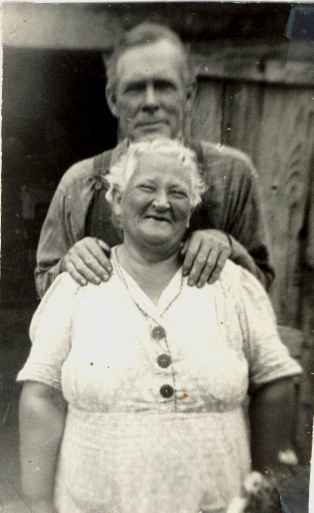
Big Mama and Pa's log house was just down the road from their house and Earl remembers spending a lot
of time there. Like most grandparents, they spoiled hm a little. Pa loved to go fishing and sometimes he let Earl
go with him. He kept his fishing poles laying up on the exposed rafters. Earl soon learned that if he wanted to
go fishing all he had to do was go out behind the barn and dig some worms. He'd take them to him and say, "Look at these
worms Pa!" Pa would reach up and take his fishing poles down from the rafters, get his hat and they would we be
off. There were several pools, or ponds, of water around about so they didn't have to go very far.
Big Mama was a kind and gentle person; she was patient with Earl and would sit for hours reading to him
and telling him stories. Sometimes she told she about the good old days before the depression. She said that they
used to go to church and that God answered a lot of prayers for them. Once they had a car and the headlights would not burn.
In fact, they had never worked since they had the car even though Pa worked on them, so they only drove it in the daytime.
Late one day they started home and it begin to get dark before they got home. Finally it got so dark Pa was afraid to go any
farther, so he stopped the car and they laid their hands on the car and prayed. You guessed it! The lights came on. Earl
knew they had a lot of faith because he could hear them praying in their house.
As I said earlier, the log house did not have electricity and neither did any of their neighbors, except
a few who had wind-chargers. Uncle Tom said that he could make one if he had the right materials. One day he came
home and said that he was going to build a wind-charger to make electricity for their house. He had bought some parts
from a neighbor's wrecked car; a six volt generator, battery and the radio. He ordered some wiring, light bulb sockets, six
volt light bulbs (they had six volt bulbs that fit a standard light socket. The bulbs were 100 watt and would burn bright
as 100 watt bulbs today. Similar to twelve volt blubs used in campers and motor homes).
He went to the woods and cut long poles and made a tower, a little taller than their house. He mounted
the generator in a spindle and fastened it on top of the tower. The generator would swivel back and forth on the spindle.
Then he whittled a propeller from a long board and fastened it to the generator. He made a tail fin for the back of the generator
that made it turn on the swivel directing the propeller always toward the wind, sort of like a windmill. He ran two wires
from the generator down to the battery and two more wires from the battery to the radio. When the wind blew the battery received
a charge and Earl heard a radio play for the first time. Then Uncle Tom installed the wiring and sockets for
the lights and they had electric lights. That was quite a big deal for them, for they always used kerosene lamps
or candles.
Some of their close neighbors would come to their house to hear the radio, especially on Saturday night to listen
to the Grand Ole Opre and the prize fights. Sometimes they would listen to programs like Fibber McGee and Molly, Amos
and Andy or a ballgame.
Sometimes when the wind did not blow for awhile the battery would go dead and Uncle Tom would ask Pat to switch
batteries and charge his as he ran the milk route. Pat did not seem to mind but he had to start the truck with a hand
crank until the dead battery was charged.
Pa & Big Mama holding their first four grandchilren,
Pa holding Buster &
Earl and Big Mama holding Wanda & Billie.
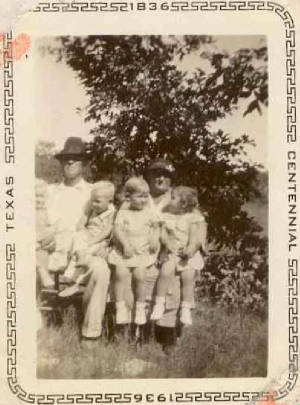
Nell had two sisters and one brother; all were married and had a child near Earl's
age. Her oldest sister was named Mozelle 'Moze' (Stone) Wheat. They lived in De Queen, Arkansas and had a daughter named
Wanda Jean Wheat. Her next sister was named Eudelle 'Pud' (Stone) Makey. She was married to Early Macky and they had a son
named Doyle Edward 'Buster' Macky. Her brother was named William Trent 'Bill' Stone. His wife was named Annie and they had
a daughter named Billie. Once they all came to visit them at one time; some staying at their house and some at Pa
and Big Mama's house. That was the first time Earl had seen them; Nell took a picture of the four
cousins and they called them the "Big Four."
In 1940 Earl started to school at the Lake Creek School, it was about a mile down the road
and he had to walk. It wasn't so bad though unless it was cold or raining. When it rained that black-land dirt became
boggy, if you know what that means, real sticky mud worse than clay. They had an old saying, "If you will stick with the land
when its dry, it will stick with you when it rains." How true! There was an old shaky footbridge that Earl had to cross
over a creek. It was scary walking across it when it rained for it was slick, shaky and slanted. The raging water was just
below him. Sometimes he walked through the deep snow, which he recalls, was not much fun.
The school was an elementary school up to the eighth grade, but there were only three rooms
in the small schoolhouse. Each room would have two or three grades in them. Their desks were in different sections of
the room and Earl's room had three grades. The teacher would go from one group to another, teaching each a few minutes
at a time. There was a large playground and ball field and Earl really liked to play ball. The school did not have inside
bathrooms, only two large outhouses. Earl had never seen an inside bathroom at this time. There was a lunchroom but he
always took his lunch because Uncle Tom couldn't afford the twelve cents a week.
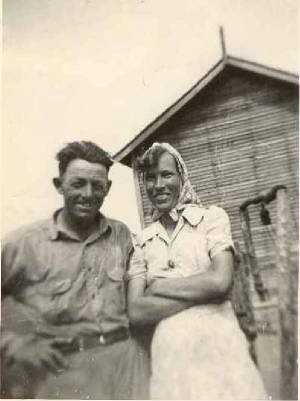
Wes Tom & Nell standing at the west end of the house they bought.
That same year, 1940, Uncle Tom and Nell bought fifty acres of farmland about
a half mile east of their log house. They bought it from Russell Edwards for $1,400. They also bought some horse-drawn farming
equipment from him for $200. They financed the sixteen hundred dollars, plus interest, at the First National Bank in
Cooper and paid it off in four annual payments. That same year, 1940, their third child was born; a son and they named
him Jerry Thomas Johnson. Uncle Tom nicknamed him JJ.
|

